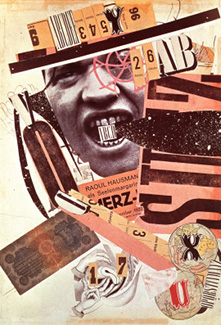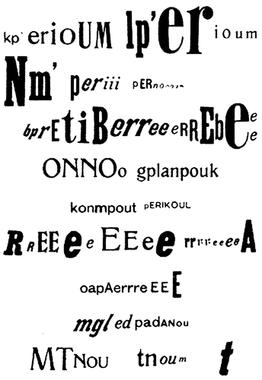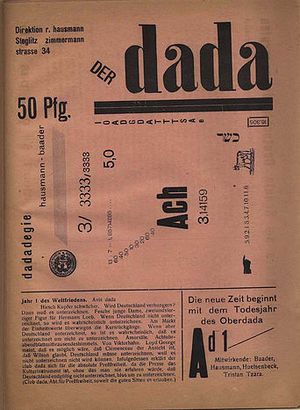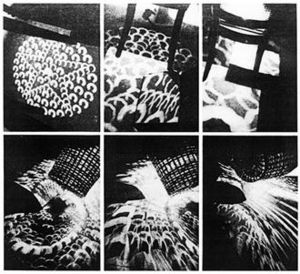Raoul Hausmann facts for kids
Quick facts for kids
Raoul Hausmann
|
|
|---|---|
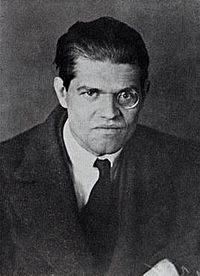
Raoul Hausmann, taken by Hannah Höch, 1919
|
|
| Born |
Raoul Hausmann
July 12, 1886 Vienna, Austria-Hungary
|
| Died | February 1, 1971 (aged 84) Limoges, France
|
| Nationality | Austrian |
| Known for | Collage, Photography, Sculpture, Poetry, Performance, Theory |
|
Notable work
|
Mechanical Head [The Spirit of Our Age], c. 1920 |
| Movement | Dada |
Raoul Hausmann (born July 12, 1886 – died February 1, 1971) was an artist and writer from Austria. He was a very important person in the Berlin Dada art movement. His special art, like photographic collages and sound poetry, greatly influenced European art after World War I.
Contents
Raoul Hausmann's Early Life
Raoul Hausmann was born in Vienna, Austria. When he was 14, in 1901, he moved to Berlin, Germany, with his parents. His first art lessons came from his father, who was a painter and art restorer.
In 1905, he met Johannes Baader, an architect who would also join the Dada movement. Around the same time, he met Elfride Schaeffer, a violinist. They got married in 1908, a year after their daughter, Vera, was born. Hausmann studied at a private art school in Berlin from 1908 to 1911.
In 1912, Hausmann saw Expressionist paintings. He started making Expressionist prints and wrote for a magazine called Der Sturm. He used this magazine to share his strong ideas against traditional art. He believed World War I would help society become better.
Hausmann met Hannah Höch in 1915. Their relationship ended in 1922. He also met Otto Gross, a psychoanalyst, and Franz Jung, an anarchist writer, in 1916. These people greatly influenced his art and ideas. Hausmann believed that destroying old ideas was a way to create new ones. This idea was a big part of his "Dadasophy," which was his way of thinking about Dada.
Becoming a Berlin Dada Artist
In 1917, Richard Huelsenbeck, one of the people who started Dada, came back to Berlin. Hausmann joined a group of young artists who were unhappy with society. This group became the core of Berlin Dada.
On January 22, 1918, Huelsenbeck gave the "First Dada Speech in Germany." Soon after, Hausmann, Huelsenbeck, George Grosz, John Heartfield, Hannah Höch, and others started the Club Dada. Their first big event was on April 12, 1918. They performed poetry and gave talks. Huelsenbeck read the Dada Manifesto, and Hausmann shouted his own manifesto, The New Material In Painting, to the excited crowd.
Creating Photomontage Art
Hausmann's idea for "new materials in painting" led to something amazing. Later in 1918, while on vacation, he saw a picture of soldiers where someone had glued photos of their son's head onto the soldiers' bodies.
Hausmann later said in 1958: "It was like a lightning bolt! I instantly saw that you could make pictures entirely from cut-up photographs. When I got back to Berlin that September, I started making these new pictures using photos from newspapers and movies."
This technique, called photomontage, became very famous with Berlin Dada artists like Hausmann, Höch, and Heartfield. It also influenced other artists like Kurt Schwitters.
At the same time, Hausmann started making "sound poems." He called them "phonemes." These poems used words that were reversed, cut up, and stretched out. He would type them with different fonts or perform them loudly. A performance of one of his poems, "fmsbwtazdu," even influenced Kurt Schwitters' famous Ursonate.
Der Dada: A New Magazine
Hausmann's art was shown in a group exhibition in April 1919. Then, in June 1919, the first issue of Der Dada magazine came out. Hausmann and Baader edited it. The magazine had drawings, strong opinions, poems, and jokes. All the text was printed using many different fonts and symbols.
In early 1920, Baader, Hausmann, and Huelsenbeck went on a six-week tour. They visited places in Eastern Germany and Czechoslovakia. They performed strange poems and recited poetry at the same time. Many people came to see them.
The First International Dada Fair, 1920
Grosz, Heartfield, and Hausmann organized the most famous Dada event: The First International Dada Fair. It showed almost 200 artworks by many artists, including Francis Picabia and Hans Arp. Key works by Grosz, Höch, and Hausmann were also there.
Even though the exhibition didn't make much money, it became well-known in cities like Amsterdam and Milan. This exhibition also influenced the "degenerate art" show put on by the Nazis in 1937. Slogans like "Take Dada Seriously!" appeared in both exhibitions.
The Mechanical Head Sculpture
Raoul Hausmann's most famous artwork is Mechanischer Kopf (Der Geist Unserer Zeit), which means "The Mechanical Head (The Spirit of Our Time)". He made it around 1920. It's the only one of his sculptures from that time that still exists.
He made it from a dummy used for making wigs. He attached different measuring tools to it. These included a ruler, parts of a pocket watch, a typewriter, some camera pieces, and a crocodile wallet.
Life After Dada
After 1920, Hausmann became good friends with Kurt Schwitters. Hausmann started to explore new art styles. In September 1921, Hausmann, Höch, Schwitters, and his wife went on an "anti-Dada" tour. Hausmann performed his sound poems. He also talked about a machine he called the "Optophone." This machine could change sound and light signals back and forth. He got a patent for this device in London in 1935. He also showed his photomontages in an exhibition in Berlin in 1931.
In the late 1920s, he became a popular photographer. He lived in a fashionable part of Berlin.
Later, Hausmann showed his photographs in many places. He focused on pictures of people, landscapes, and portraits. As the Nazis started to persecute modern artists, he moved to Ibiza. There, he took photos of the traditional life of the people on the island.
He went back to Czechoslovakia in 1937. But he had to leave again in 1938 when Germany invaded. He moved to Paris, then to a quiet place near Limoges, France. He lived there secretly with his Jewish wife, Hedwig, until 1944. After the war ended, they finally moved to Limoges.
After the war, Hausmann could work openly as an artist again. He started writing to Schwitters to plan a poetry magazine, but Schwitters died in 1948, and the project stopped. Hausmann wrote books about Dada, including his autobiography Courier Dada (1958). He also made "photograms," photomontages, and sound poetry. In the 1950s, he even started painting again.
Renewed Interest in Dada
In the 1950s, people became interested in Dada again, especially in America. Hausmann started writing to many American artists. They talked about Dada and how it related to new art. He did not like the term "Neo-Dada," which was used for artists like Yves Klein and Robert Rauschenberg.
He wrote to George Maciunas, who had shown his work in early Fluxus events, in 1962: "I think even the Americans should not use the term 'neodadaism' because neo means nothing and ism is old-fashioned. Why not simply 'Fluxus'? It seems to me much better, because it's new, and dada is historic. I was in correspondence with Tzara, Hulsenbeck and Hans Richter concerning this question, and they all declare 'neodadaism does not exist'... So long."
Raoul Hausmann died on February 1, 1971, in Limoges. His last book, Am Anfang war Dada (In the Beginning Was Dada), was published after he died in 1972.
Hausmann's Scientific and Technical Work
Besides being an artist, Hausmann was always interested in science and technology. He was especially curious about new fields like television and sound film.
In 1929, he received a patent for a "device for monitoring body cavities and tubes." Today, we would call this an endoscope. While studying light and electronics for his art, Hausmann worked with a Russian engineer named Daniel Broido. They designed a computer that used similar technology. This device was given a patent in Britain in 1934.
See also
In Spanish: Raoul Hausmann para niños


